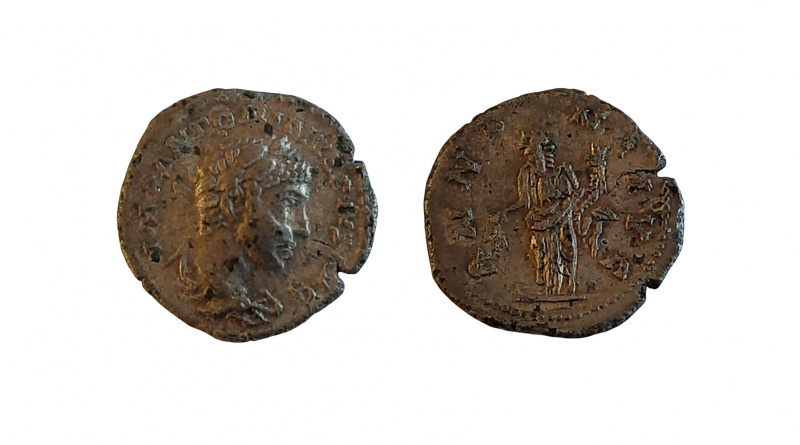Denarius of Elagabalus
This Roman denarius was unearthed from a footpath by George Bates 50 years since. It was the first denarius that George had found and at first sight it looks like a fairly straightforward coin of Elagabalus (AD 218-22). The birth name of this emperor was Varius Avitus Bassianus but later in life his name was changed to M. Aurelius Antoninus. Whilst still young he became priest of the Sun God Elagabalus and it is by that name he is best known.
On the obverse of this denarius the legend reads IMP ANTONINVS PIVS AVG around the laureate head of the emperor. On the reverse the standing figure of Annona holds in one hand a cornucopia and corn ears in the other and is accompanied by a legend reading ANNONA AVG. This is where things become much less straightforward.
Mule
Both dies used to strike this denarius are not of the best quality but neither are bad enough to raise suspicion. However, George could not trace this die paring so he wondered if the coin could be a mule.
I did a good deal of research but the only ANNONA AVG reverse die I traced was used for Severus Alexander in AD 226, which was four years after the death of Elagabalus. If this denarius was an official issue then it would mean that an obverse die that was at least four years old was used during the reign of Severus Alexander. To me this seemed highly unlikely.
Modern copy
Many quite convincing copies of Roman denarii have been made in Bulgaria over recent years. Some of these seem to be mules but this is probably due to the makers mixing up dies by mistake. Fortunately, such errors can make the fakes easier to identify. If George’s denarius had turned up recently I would have been pretty sure it had been made in Bulgaria. However, this possibility could be discounted as the coin had been found 50 years since.
Sam Moorhead
After a good deal of thought and research I decided to ask Sam Moorhead for his opinion. Sam said he believed it could be plated rather than solid silver and that he had seen many mules and hybrids of the same period. Working just from photographs the coin looked to me to be solid silver but Sam’s mention of mules and hybrids explain why this denarius has an anomalous die pairing.
Sam wanted to include the coin on the PAS website, so George was forwarding photographs and all the necessary details.
Valuation
Were this coin an official issue of Elagabalus or Severus Alexander then in its present condition it might be worth around £20. As it is a strange and rather interesting curiosity then I’d say a specialist would be willing to pay £30-40 for it.
Valuation Service
If you would like your coin identified or valued, please read about my valuation service and contact me

